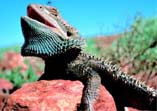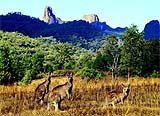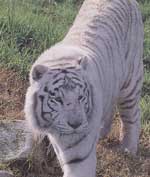Bingara
Bingara is a quiet and friendly country town located on the permanently flowing Gwydir River. Apart from the great natural beauty, this spot is thought to have the best fishing in New England.
Oz Experience buses stop overnight with international tourists and many of those enjoy horse rides along the banks & through the river. There is also canoeing and river rafting, and for those who like to try their luck, this is a great place for a bit of fossicking.
In 1827 the botanist/explorer Allan Cunningham travelled up the valley from Tamworth. He camped on the junction of Halls Creek and the Gwydir River, which he named after his benefactor, Lord Gwydir. Cunningham's glowing reports of the area brought an immediate flow of graziers and the discovery of gold in 1853 and diamonds in the 1880s saw rapid development in the area.
Bogan
Located half way between Sydney and Broken Hill, Bogan Gate may only be small, but is boasts of being the hometown of author Merrill Findlay who wrote "Republic of Women".
The old railway station at Bogan Gate is now an Arts and Crafts Centre.

Bogan's general store.
Bourke
Average summer day temperature: 36.4°C
Average winter day temperature: 17.9°C
Average annual rainfall: 355.1mm
Average clear days: 203.4
On the banks of the Darling River, Bourke is 786km north west of Sydney and is often called the 'Gateway to the Real Outback'.
The town has many links with Australia's early history; the explorers Sturt, Mitchell and Oxley all passed close by the site of the present township; paddle-wheel steamers travelled up the Darling River as far as Bourke with cargoes of wool; and Cobb & Co coaches served the town and much of the surrounding district.

Native lizard, Bourke.
Cobar
Average annual rainfall: 425.0mm
Situated in a grazing area featuring large station properties, Cobar is the site of one of the largest copper mining operations in Australia. Overlooking the original open-cut mine is the Pastoral, Mining and Technological Museum and visitors to the town are able to tour a copper and zinc mine. West of Cobar are the Mt Grenfell Aboriginal cave paintings.
Coonabarabran
Average summer day temperature: 31.7°C
Average winter day temperature: 14.8°C
Average annual rainfall: 749.5mm
Average clear days: 144.2
Situated at the intersection of the Newell and Oxley Highways, Coonabarabran is almost enveloped by the amazing Warrumbungle Range, a place of spectacular scenery. Close by is the Siding Spring Observatory, with its exhibition on astronomy and five operational optical telescopes.

Warrumbungle National Park, Coonabarabran
Coonamble
Average summer day temperature: 34.9°C
Average winter day temperature: 17.0°C
Average annual rainfall: 504.0mm
Average clear days: 145.4
Situated on the Castlereach River on the north-western plains, Coonamble takes its name from the aboriginal word meaning 'plenty of dirt'. The town services a rich pastoral ara where beef cattle, wheat, and wool are the main industries.
Dubbo
Average summer day temperature: 33.0°C
Average winter day temperature: 15.2°C
Average annual rainfall: 588.8mm
Average clear days: 139.5
Dubbo is located on the Macquarie River 412 km northwest of Sydney, and is a vital railway link between Sydney and the Far West. This area houses the regional headquarters of some government agencies and includes a large RAAF depot.
When you're next in Dubbo, make sure to visit the remarkable Western Plains Zoo, an open-range zoo which specialies in large animals and places them in areas which are 'caged' by moats, thus giving the feeling of naturalness. Other sites to visit are the Pioneer Museum and the Old Dubbo Jail.

A rare white Bengal tiger in residence at Dubbo's Western Plains Zoo.
Lightning Ridge
Average summer day temperature: 35.2°C
Average winter day temperature: 18.7°C
In 1900, a boundary rider named Jack Murray found Opal at Lightning Ridge. The town has since become the World Capital of Black Opal. There is plenty to see in this small town, from collections of rare Opal, to a bush museum. There are open gardens, jewelry awards, the Black Opal Rodeo, and much more.

Rich opal discoveries have been made at White Cliffs and Lightning Ridge.
Mudgee
Average summer day temperature: 30.0°C
Average winter day temperature: 14.0°C
Average annual rainfall: 667.0mm
Once the centre of a gold mining distract, Mudgee has now become the centre of a wine producing area. The town, originally settled by the Blackman family in the 1830s, is located west of the Great Dividing Range on the Cudgegone River
Wellington
Wellington is located between Mudgee and Dubbo in northwestern NSW. It is a fascinating town with any historical sites (including the site of the last pistol duel fought in Australia). If you include the surrounding area, the population of Wellington swells to 10,000 people. Visitors to the area should visit the Wellington Caves and the Burrendong Dam.






